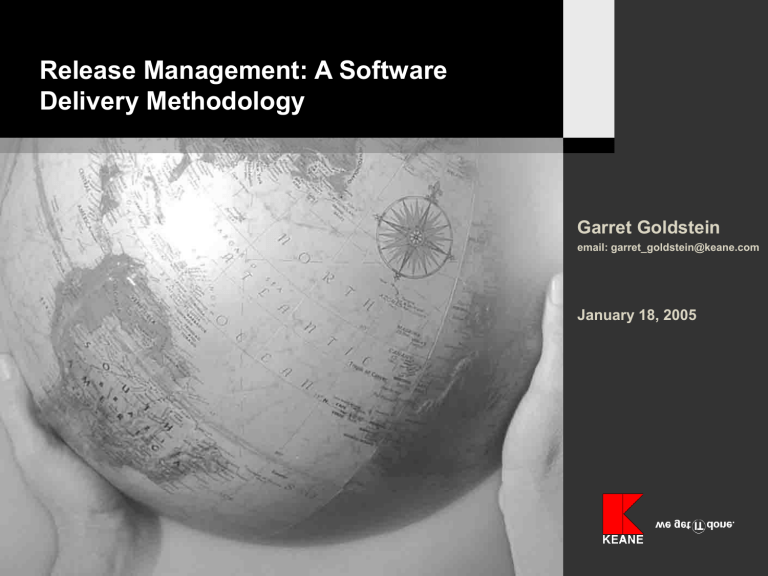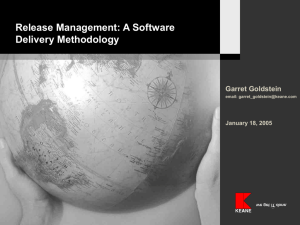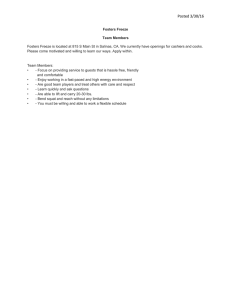
Release Management: A Software Delivery Methodology Garret Goldstein email: garret_goldstein@keane.com January 18, 2005 “…Predictability is one of IT's most elusive goals…” Name: Laurent Séraphin Title: EMEA Product Director Company: Borland Systems Lifecycle 3 Application Management - Typical Problems • Inability to track and manage multiple projects affecting the same or multiple systems with multiple end dates and multiple business owners. • Lack of predictability in delivery timeframes, costs, and support requirements. – IT: “You will get it next phase…” Business: “Yeah right…” • Escalation management paradigm <squeaky wheel syndrome followed by whiplash syndrome>. • Total breakdown in business owner confidence and trust (credibility) in IT’s ability to deliver. • Risk to application uptime. 4 A Solution!!!! Release Management 5 A model of predictability 6 What is Release Management? • Release Management (aka Release Train) can be defined as a methodology for planning and implementing an integrated set of functional components and processes in a controlled manner. – Date driven; releases are scoped in order to meet pre-specified delivery dates, the project management “Iron Triangle” balanced on the schedule apex. – Reversed planned; start with your target implementation dates and work backwards. – Mechanized; process should try to emulate a typical factory operation. – Forecasted schedules as well as functionality; force an organization to strategize and plan in advance. – Integrated and predictable; many business needs folded into one release, and everyone knows the schedule. – Uses standard system development lifecycle (SDLC) and project management methodologies (PMBOK) and best practices 7 Benefits of Release Management • Provides for an integrated (and transparent) view of both business and IT plans – Open planning can provide a clear view of what is being developed, and when the key milestone will be achieved. • Results in a more stable production system – The introduction of an integrated release early in the development cycle allows for more careful analysis and testing of impact to normal operations. • Creates predictability in delivery timeframes, costs, and support requirements – Release Management provides all corporate entities with a clear view of the functionality being delivered and release scheduling, both in the short and long run. • Allows for the utilization of corporate resources consistent with corporate priorities • Used by many large organizations such as Cisco, Sun, etc. 8 Release Management Release Planning • What are the systems? Is there a grouping of systems? • How many releases? • When to release? • How much overlap? Q1 04 J F Q2 04 M A M Q3 04 J J A Q1 05 Q4 04 S O N D J F M Release 1 Release 2 Release 3 Release 4 9 Release Management Release Lifecycle • Each release will have a lifecycle, with phases. – i.e. Initiation, Planning, Build, Deployment and Close Out • Identify within each phase a key milestone(s). • Manage each release to these milestones. Q1 04 J F Q2 04 M A M Requirements Scope Development Quality Control Freeze Freeze Freeze Complete J Deployment 10 Release Management Release Scheduling • Need to determine the duration of each release. – i.e. 4 releases in a year, therefore each release is 3 months. • Determine the percentage of time each phase will occupy. • Choose your release date(s) and reverse plan the release. Percentage Key Milestones Duration (months) = 6 Schedule Initiation Planning Build Deployment 10% 20% 45% 25% Release Scope Requriements Freeze Freeze Development Freeze Quality Control Complete/Deployment 0 1.2 2.7 1.5 26-Mar-05 7-May-05 30-Jul-05 15-Sep-05 11 Release Management Rigidity versus flexibility • Rigidity of the release schedule is dependent upon the organization implementing Release Management. • Typically, there is a process for introducing “Hot Fixes” in between release deployment dates. – Constrained to only include Priority 1 system bugs, or “Business Critical” enhancements. – Exceptions and not the norm, otherwise the organization risks losing the benefits. – Determine, well in advance, the number and type of Hot Fixes the RM team can absorb without putting the release in jeopardy. • To allow for some level of flexibility, the release dates can be given a plus or minus factor. – Allow the team to either expand or contract the release schedule depending on different constraints. – Changes to release dates will cascade down to subsequent releases, therefore Change Management is critical. 12 Release Management Multiple Systems/Multiple Business Requests • Typically with an enterprise, there are a series of systems that may be either tightly or loosely coupled. – Groupings of systems; i.e. Provisioning Systems versus Operations Systems – Upstream versus downstream • There may be any number of organizations with business requests resulting in development on one or more of the systems. – May or may not have shared needs or competing needs – Need must be integrated • Release planning sessions that include all appropriate organizations from the lines of business and IT. – Determine the critical scope or “Anchor Functionality” and the reserve for unknown functionality. – Rolling 12 month view of the release plan, therefore meet regularly. 13 Release Management Release Roadmap Q1 J F Q2 M A M Project 1a (OPS) Project 2 (Strategy) Unknown (5%) Q3 J Q2 M A Requirements Scope Freeze S O M J A D J M Release Package 3 15-Apr-06 Q4 S F Project 1c (OPS) Project 6 (Engineering) Unknown (25%) Q3 J Q1 N Release Package 2 15-Dec-05 Q1 F A Project 1b (OPS) Project 3 (Engineering) Project 5 (OPS) Unknown (10%) Release Package 1 15-Aug-05 J J Q4 O N Q1 D J F M Development Testing Deploy Freeze Requirements Scope Freeze Development Testing Deploy Freeze Requirements Scope Freeze Development Testing Deploy Freeze 14 Release Management Integration Points • Need to determine where an integration point should be planned within the RM lifecycle. • May be a temptation to only concentrate on those functionalities that appear, during analysis phase, to be interrelated. Business Request 1 Business Request 2 Business Request 3 The development of all requests are completed on or near same date. All move in uniform fashion to integrated testing All business requests are scoped as one release. Requests are gated prior to deployment and deployments are coordinated to include 1 to n business requests. All requirements are reviewed in an integrated fashion No Release management Requirements Scope Development Baseline Baseline Complete Quality Control Complete Deployment 15 Release Management Make if official • Use System Development Lifecycles (SDLC) such as the Waterfall or Rational Unified Process (RUP) approaches. • Use Project Management best practices, i.e. PMBOK. – Each release could be viewed as a project. • Formally document the policies and operating principles, such as: – Scope Management – Metrics Management – Quality Management – Change Management – Strategic Release Planning – Integrated Testing – Risk Management 16 Release Management Roles • Release Manager – A project manager whom manages release. • The release, the whole release and nothing but the release. – Must be thick skinned! • Business Project Manager – Focused on the business needs. – Natural tension with Release Manager. • Development Manager • Configuration Manager • Environments Manager • Testing Manager 17 Release Management Information Management Tools • Release Management Planning and Deployment tool (RMPD) – Tracking of multiple business requests, the associated software deliverables of those requests, as well as release planning and scheduling, and the association of software deliverables contained within a release. – Open-view of planned releases and the functionality for each release. – Automate additional Project Management tasks geared towards the release. – Integrated with other IT tools, such as Defect Tracking, Budgeting, etc. • There is not a strong suite of tools currently available for managing the release management process. – Maybe the Rational Suite – MS Excel – MS Project – Homegrown 18 Release Management Summary • IT organizations are losing credibility due to their inability to provide predictability in software delivery timeframes, costs, and support requirements. This is particularly evident during the Application Management phase of a systems lifecycle. • Release Management is a methodology that provides predictability, stability and transparency to software delivery. • Planning, planning, planning. – A release in June might start in January • Scope takes a back seat to schedule. • Not a silver bullet, the implementing organization must truly understanding the business objectives and the tradeoffs. 19 Questions and Answers. Thanks for listening!!! Garret Goldstein email: garret_goldstein@keane.com




